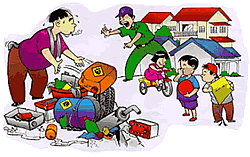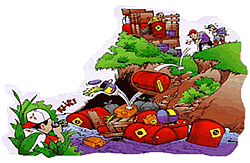









 |

 |
 |
PCB Symposium 2002 in Japan |
|
 |
 |
| Country report from Malaysia |
 |
|
|
Page 1 2
3
Industrial sources of
PCBs
The three types of industries that have been
dominating the manufacturing sector are the electronics
and electrical sector, the textiles and apparels, and
the food and beverages. Most of the factories under the
electronic and electrical sector are producing semiconductors,
computers and peripherals while the fabricated metals
sector manufactures jigs and fixtures, stamped metal parts,
injection steel moulds wire hardeners, bolts nuts and
screws.
Malaysia is a major exporter of passive components with
a total export value at RM2.7 billion (US$710 million)
in 1999.
More than 170 companies are involved in the manufacture
of a wide range of product that includes capacitors, resistors,
inductors, coil transformers magnets, quartz crystals
and oscillators. Capacitors and resistors alone have export
values amounting to RM1.5 billion (US$395 million) and
RM600million (US$158 million) respectively.
Along with the rapid industrial development is the generation
of a large quantity of hazardous and non - hazardous waste,
which needs to be properly treated and disposed. Among
the steps taken to curb this problem is the enactment
of laws to protect the environment and human health from
being exposed to toxic chemicals. Generally industrial
waste is referred to as scheduled wastes.
Legislation on PCBs
Legislation pertaining to scheduled wastes comes under
the purview of the Department of Environment (DOE).
Under the Environmental Quality (Scheduled Waste) regulation
1989, 107 categories of hazardous waste are defined,
as "scheduled wastes" of which is PCBs.
Scheduled wastes as defined in the First Schedule to
the Environmental Quality (Scheduled Waste) Regulations
1989 is basically hazardous waste generated principally
from industry. The generation, handling, transportation,
treatment, storage and disposal of scheduled waste are
governed by three sets of legislations, which are:
- The Environmental Quality (Scheduled Waste) Regulation
1989.
- The Environmental Quality (Prescribed Premises)
(Scheduled Waste Treatment
and Disposal Facilities) Regulation 1989.
- The Environmental Quality (Prescribed Premises)
(Scheduled Waste Treatment
and Disposal Facilities ) Order 1989.
These regulations require acceptable method of storage
transportation and disposal, the facilities of which
must be licensed by the Department of Environment. (DOE)
Under the prescribed legislation, hazardous wastes are
classified as scheduled wastes.
However there is no precise definition for scheduled
waste as it can be classified into three large groups
- By- products generated in the production processes
- Sludge resulting from waste- water treatment
- Toxic items whose expiry date has passed.
Even though the regulations cover scheduled waste,
current definitions do not cover hazardous domestic
waste such as batteries, fluorescent lamps, paints and
chemicals (pesticides). Hazardous waste may be mixed
with non - hazardous municipal waste.
Between 1995-1999, an average of 431,000 tons of scheduled
wastes was generated per annum, these were mainly from
the metal finishing, electronics, textile, chemical
and chemical-related industries, agricultural and domestic
activities and clinical waste from hospitals.
Companies are required to inform the authorities about
hazardous waste and whether there is a need for associated
collection, storage and processing.
In spite of the existing legislation on scheduled waste
the private sector is reluctant to invest in systems
that meet DOE discharge standards. This has resulted
in many prosecutions but even so a large number of companies-
particularly the small and medium enterprises still
continue to flaunt the law. The DOE has no means of
verifying the amount of waste produced by an organization
and in most cases how the waste is being disposed. There
is no legislation for "complete reporting."
In the case of toxic waste, a joint venture integrated
treatment system (Kualiti Alam Sdn .Bhd) was commissioned
in 1997. It uses Danish technology to treat and dispose
107 types of scheduled waste (which includes PCBs) listed
in the Environmental Quality Act. However, only a small
proportion of the 800,000 tons of toxic industrial waste
generated annually by local industry is treated in this
facility.
In practice it is revealed that only 22% of the 3000
factories generating toxic wastes are registered with
Kualiti Alam (the company responsible for disposal of
toxic waste in Malaysia.)
Many industries not only lack the technical expertise
in the management of such kinds of wastes but also suffer
from shortage of space. In some cases the storage practice
is improper and unsatisfactory leading to probable risks
of spillage, leakage, fire and explosion. There were
also instances in which the scheduled wastes were illegally
dumped at some residential and environmentally sensitive
areas.
Contaminated land has not been a major problem in Malaysia
due to its relatively short history in industrialization
and the availability of green sites for new industries.
There has been very little redevelopment of old industrial
properties.

Scheduled waste kept at the premises of factories
|

Hazardous waste materials left lying around the factory |
The DOE plans to monitor land and groundwater contamination
as news of illegal dumping of hazardous waste are being
reported in the media on. In order to curb the problem
of illegal dumping and educate the public on the dangers
of hazardous waste the Department of Environment has
come out with a campaign to 'STOP ILLEGAL
DUMPING OF HAZARDOUS WASTE.'
DEPARTMENT OF
ENVIRONMENT MALAYSIA
MINISTRY OF SCIENCE, TECHNOLOGY AND THE ENVIRONMENT
STOP ILLEGAL DUMPING OF HAZARDOUS WASTES
| 
|
Be suspicious of any dumping of drums, hdpe/plastic
containers or sacks containing foul-odoured, coloured
or reactive liquid or sludge. |
Ensure that your neighbourhood or surrounding
is not a dumping ground for hazardous waste.
|
 |
|
Page 1 2 3
|
|
